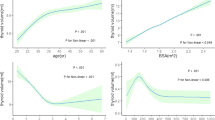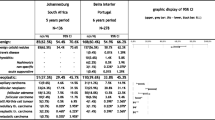Abstract
Purpose
To explore whether there are regional differences in iodine status and in prevalence of thyroid diseases in the two main regions of Belgium.
Methods
A national survey of iodine status among children was performed in 1998. The raw data of this survey were reanalyzed to explore regional differences. The total number of thyroidectomies, carried out for multinodular goiter or solitary nodules, was obtained from the Minimal Clinical Summary hospital discharge database. Percentage of people with thyroid diseases going to the general practitioner or the specialist was assessed by means of data about the number of adults using anti-thyroid medications. Food consumption patterns were explored using national food consumption data.
Results
In Flanders, median urinary iodine concentration (UIC) was higher than in Wallonia, 84 μg/L (n = 1,316) and 78 μg/L (n = 1,268), respectively (p < 0.001). There were no differences in goiter prevalence and thyroid volume between the regions among children. Data from the food consumption survey showed a significant higher consumption of seafood in Flanders compared to Wallonia. Further, it was observed that the number of thyroidectomies, carried out for MNG or solitary nodules, and the use of anti-thyroid medication were significantly higher in Wallonia than in Flanders.
Conclusion
Iodine status in children was found slightly different in both regions of the country. This finding is in agreement with a higher incidence of thyroidectomies and more extensive use of anti-thyroid medications in the adult population in the region with the lowest iodine excretion.
Similar content being viewed by others
References
De Benoist B, McLean E, Andersson M, Rogers L (2008) Iodine deficiency in 2007: global progress since 2003. Food Nutr Bull 29:195–202
Zimmermann MB, Jooste PL, Pandav CS (2008) Iodine-deficiency disorders. Lancet 372:1251–1262
World Health Organization, UNICEF (2007) Iodine deficiency in Europe: a continuing public health problem. World Health Organisation, Geneve
Ciardelli R, Haumont D, Gnat D, Vertongen F, Delange F (2002) The nutritional iodine supply of Belgian neonates is still insufficient. Eur J Pediatr 161:519–523
Delange F, Van Onderbergen A, Shabana W et al (2000) Silent iodine prophylaxis in Western Europe only partly corrects iodine deficiency; the case of Belgium. Eur J Endocrinol 143:189–196
Bourdoux P (1990) Borderline iodine deficiency in Belgium. J Endocrinol Invest 13:77
WHO/UNICEF/ICCIDD (1994) Indicators for assessing iodine deficiency disorders and their control through salt iodization. World Health Organisation, Geneva. Report no.: WHO/NUT/94.6
Moreno-Reyes R, Vanderpas J, Neve J, Vandevijvere S, Van Oyen H (2008) A new strategy to optimize iodine intake in Belgium. ICCDD: IDD Newsletter August 2008
Laurberg P, Nohr SB, Pedersen KM et al (2000) Thyroid disorders in mild iodine deficiency. Thyroid 10:951–963
Laurberg P, Cerqueira C, Ovesen L et al (2010) Iodine intake as a determinant of thyroid disorders in populations. Best Pract Res Clin Endocrinol Metab 24:13–27
Koutras DA, Alexander WD, Buchanan WW, Crooks J, Wayne EJ (1960) Stable iodine metabolism in non-toxic goitre. Lancet 2:784–787
Glinoer D, Lemone M (1992) Goiter and pregnancy: a new insight into an old problem. Thyroid 2:65–70
Baltisberger BL, Minder CE, Burgi H (1995) Decrease of incidence of toxic nodular goitre in a region of Switzerland after full correction of mild iodine deficiency. Eur J Endocrinol 132:546–549
Vandevijvere S, Annemans L, Van Oyen H, Tafforeau J, Moreno-Reyes R (2010) Projected reduction in healthcare costs in Belgium after optimization of iodine intake: impact on costs related to thyroid nodular disease. Thyroid 20:1301–1306
Delange F, Benker G, Caron P et al (1997) Thyroid volume and urinary iodine in European schoolchildren: standardization of values for assessment of iodine deficiency. Eur J Endocrinol 136:180–187
De Vriese S, Debacker G, de Henauw S et al (2005) The Belgian food consumption survey: aims, design and methods. Arc Public Health 63:1–16
Vandevijvere S, De Vriese S, Huybrechts I et al (2009) The gap between food-based dietary guidelines and usual food consumption in Belgium. Public Health Nutr 12:423–431
Nusser SM, Carriquiry AL, Dodd KW, Fuller WA (1996) A semiparametric transformation approach to estimating usual daily intake distributions. J Am Stat Assoc 91:1440–1449
Dodd KW (1996) A technical guide to C-SIDE. Software for intake distribution estimation. Department of Statistics and Center for Agricultural and Rural Development; Iowa State University. Report no.: Technical report 96-TR 32
Iowa State University (1996) A user’s guide to C-SIDE. Software for intake distribution estimation. Department of Statistics and Center for Agricultural and Rural Development Iowa State University. Report no.: Technical report 96-TR 31
Brull L, Dewart L (1956) Répartition et féquence du goitre chez les recrues en Belgique. Rev Med Liege 11:653–656
Bouckaert A, Beckers C, Francois B (1978) Screening of the thyroid function of newborns in Southern Belgium. Int J Epidemiol 7:249
De Vriese S, Huybrechts I, Moreau M, Van Oyen H (2006) De Belgische Voedselconsumptiepeiling 1: Rapport. Wetenschappelijk Instituut Volksgezondheid, Brussels, Belgium. Report no.: D/2006/2505/15-18
Knudsen N, Bulow I, Jorgensen T, Laurberg P, Ovesen L, Perrild H (2000) Comparative study of thyroid function and types of thyroid dysfunction in two areas in Denmark with slightly different iodine status. Eur J Endocrinol 143:485–491
Rasmussen LB, Carle A, Jorgensen T et al (2008) Iodine intake before and after mandatory iodization in Denmark: results from the Danish investigation of iodine intake and thyroid diseases (DanThyr) study. Br J Nutr 100:166–173
Als C, Haldimann M, Burgi E, Donati F, Gerber H, Zimmerli B (2003) Swiss pilot study of individual seasonal fluctuations of urinary iodine concentration over 2 years: is age-dependency linked to the major source of dietary iodine? Eur J Clin Nutr 57:636–646
Author information
Authors and Affiliations
Corresponding author
Rights and permissions
About this article
Cite this article
Vandevijvere, S., Dramaix, M. & Moreno-Reyes, R. Does a small difference in iodine status among children in two regions of Belgium translate into a different prevalence of thyroid nodular diseases in adults?. Eur J Nutr 51, 477–482 (2012). https://doi.org/10.1007/s00394-011-0232-1
Received:
Accepted:
Published:
Issue Date:
DOI: https://doi.org/10.1007/s00394-011-0232-1




